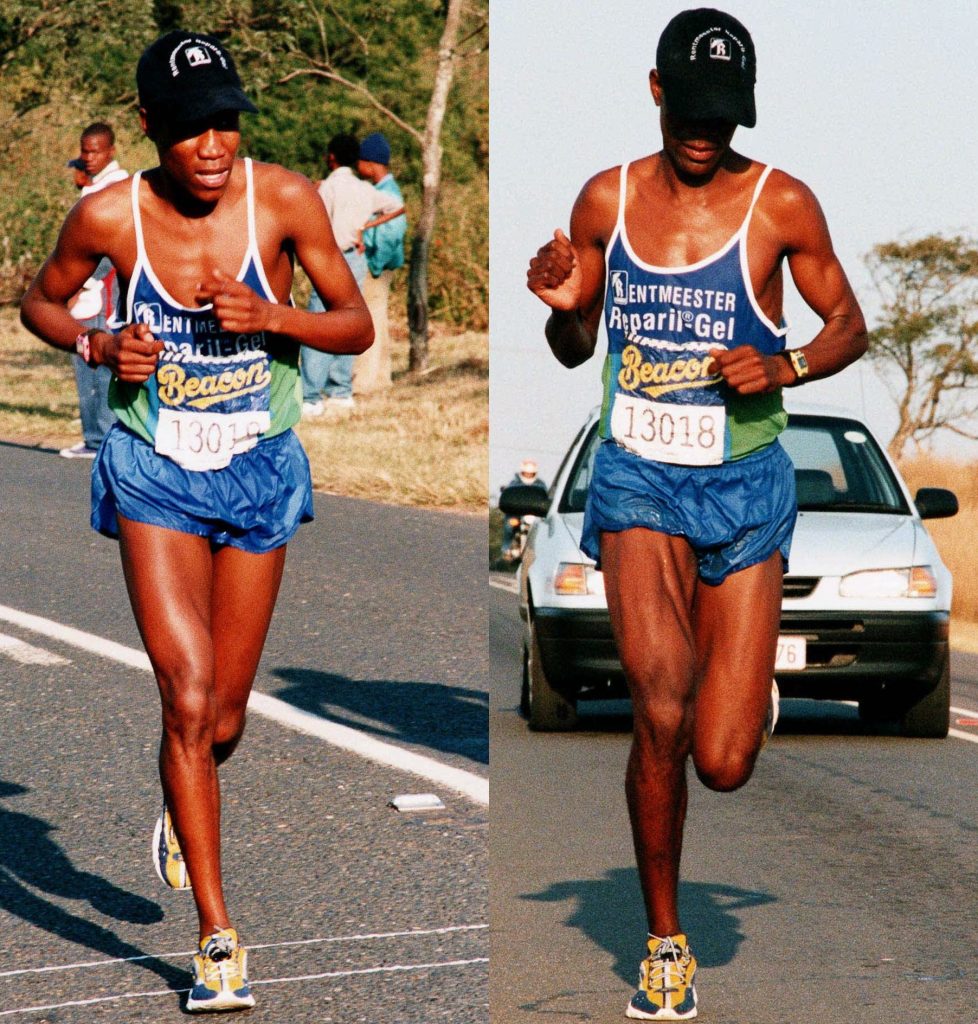What Cheaters Should Watch Out For
Marathons are very long races — 26.2 miles, or a bit more than 42 kilometers. And yet, they are not the longest races in the world. If you’re a runner and you really want to test yourself, there are ultramarathons, and they are brutal. One of the oldest existent ultramarathons, the Comrades Marathon, is a great example. It takes place in South Africa and was first established in 1921, and typically has more than 10,000 entrants — but hardly that many finishers. The race is roughly 55 miles (88 km) — more than twice a typical marathon — and if you don’t finish it in the first 11 hours or so, a rescue vehicle comes and picks you up (even if you don’t want to be rescued). As the New York Times reported, in the 1999 race, about 1,500 competitors (~10% of entrants) were unable to finish.
Sergio Motsoeneng, pictured below, wasn’t one of those unfortunate ten percent. In fact, he finished in the top ten. And that’s where his problems began.
Below are two photos taken of Motsoeneng during the race — and they resulted in his downfall. Do you see why?

If you don’t, don’t worry — you were hardly alone.
At the time of the race, Sergio Motsoeneng was 21 years old and living not to far from the race course. He had never entered the Comrades Marathon before, which made his 9th place finish unusual — while many people enter the race, the top finishers are a rare breed who compete in ultramarathons across the globe and typically know one another. For a total newcomer to simply appear and finish toward the top is, while not unheard of, quite rare.
And for these top-flight runners, the race isn’t simply an endurance test but an actual competition to see who can come in first. They aren’t just aware of their own time and position — they often pay attention to the other elite runners on the course, tracking who passes them. After Motsoeneng’s finish, another runner (and former Comrades Marathon champion), Nick Bester, shared a concern. As Business Insider reported, “a timing mat showed that the runner registered as Sergio Motsoeneng passed the race’s halfway point 7 minutes behind Nick Bester. But somehow, that same runner beat him by eight minutes.” Bester didn’t recall Motsoeneng ever overtaking him — and he tracked such things — and suspected that Motsoeneng somehow left the course, took a shortcut.
An initial inquiry cleared Motsoeneng of any wrongdoing. But Bester and others were convinced otherwise. And then, a local newspaper shared the photos above.
If you still don’t see the issue, the title of today’s story is a clue. (I’ll give you another few moments to look at the photos again.)
(Ready?)
(OK!)
In the photo on the left, Motsoeneng is wearing his watch on his right wrist (and it is pink, but that’s harder to see). In the one on the right, it’s a yellow watch, and it’s on his left wrist. Somehow, mid-race, his watch jumped across his body and changed colors.
Faced with this evidence, Motsoeneng admitted that he had cheated — and he wasn’t alone. Sergio Motsoeneng had a secret weapon: a younger brother, Fika, then 19 years old, and very similar-looking to his older brother. Atlas Obscura explains what happened next:
Forty-five minutes into the race, Sergio ducked into a porta-potty. Inside, his identical brother, Fika, was waiting. Sergio removed his shirt, bib, hat, and even shoes, and gave them to his brother, who continued the race. The race organizers figured that this bait-and-switch happened on more than one occasion throughout the 90-kilometer course. The siblings had organized their own relay.
(They switched shoes because Sergio’s were outfitted with a tracking chip, as were the other entrants’ sneakers.)
The benefit from getting breaks during the grueling race, combined with the fact that they only had to run half of it, was probably enough to give the brothers a boost into a prize money finish. (It’s still unclear how the brothers leapfrogged the other runners without actually passing them on the course.) Faced with the photographic evidence of his cheating, Sergio (and his brother) fessed up. They explained that the prize money — about $1,000 — plus the gold medal, were the motivation; the brothers were living in poverty and the money (and money from selling the medal) would help them and their family buy groceries.
The somber explanation wasn’t enough for race organizers to look the other way. The brothers were banned from the Comrades Marathon for a decade, and Sergio ultimately was banned again after a positive drug test in 2010. But there is a silver lining for Sergio, literally: As News24 South Africa reported, he kept running and found success in other races, winning seven silver medals in 13 other races between 1999 and 2010.
Bonus fact: There’s a dark side to marathons that often goes unaccounted for: according to USA Today, “More people die of heart attacks and cardiac arrest when they fall ill during marathons.” And USA Today isn’t talking about people who are running the races — the newspaper is referring to everyday people who have heart attacks while, coincidentally, there’s a marathon taking place nearby.
The issue, according to a study in the New England Journal of Medicine, is the change in traffic patterns to accommodate the runners. The study focused on the Boston Marathon and, per USA Today, found that “traffic jams and route disruptions caused by marathons meant it took longer to bring patients to the hospital. Ambulance rides lasted 4 minutes longer — 18 minutes instead of 14 — and private cars likely sat in traffic even longer.” The result? “The 30-day death rate from heart attacks and cardiac arrest jumped 15% for people who fall ill on marathon days in 11 U.S. cities.”
From the Archives: The Missing Marathoner: He ran — and then he ran away.
